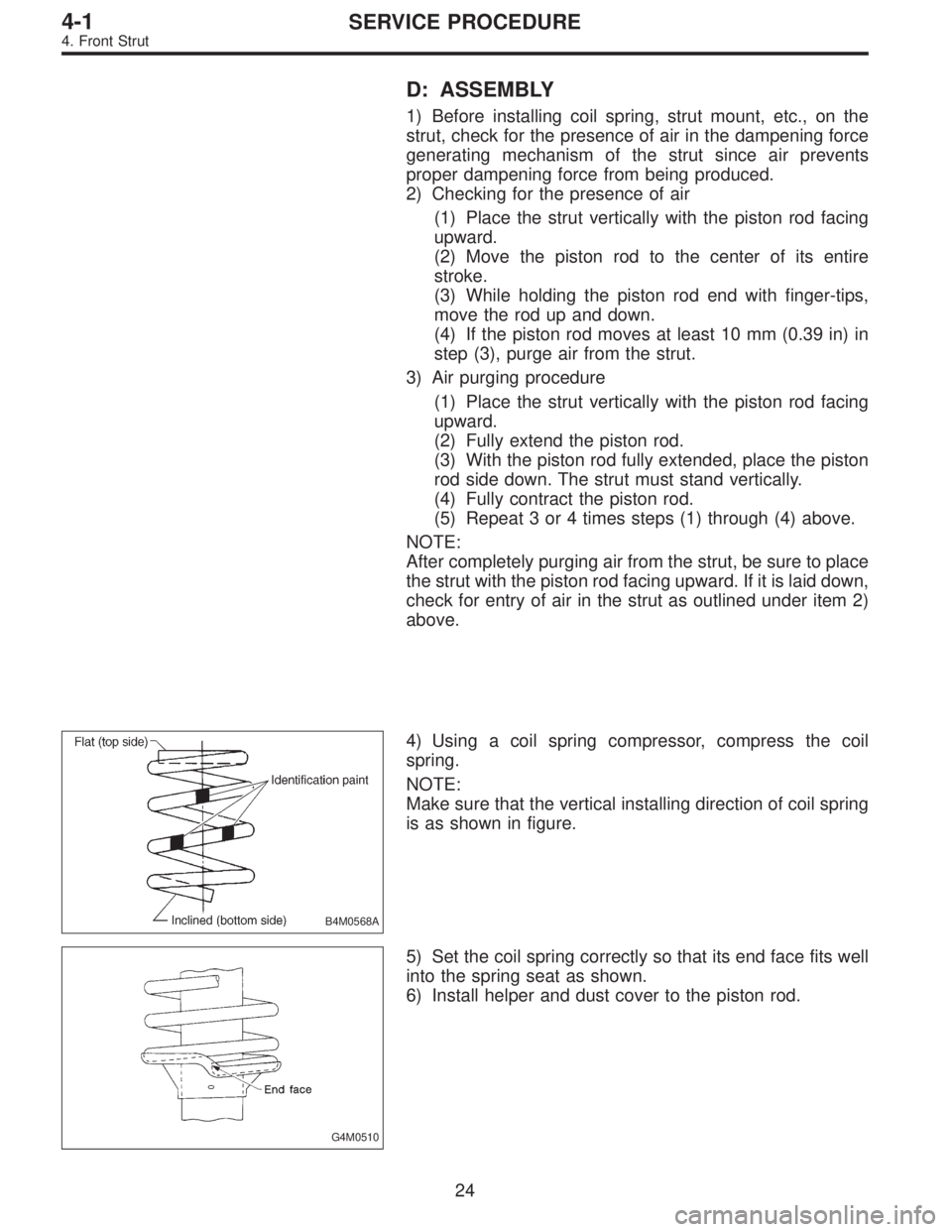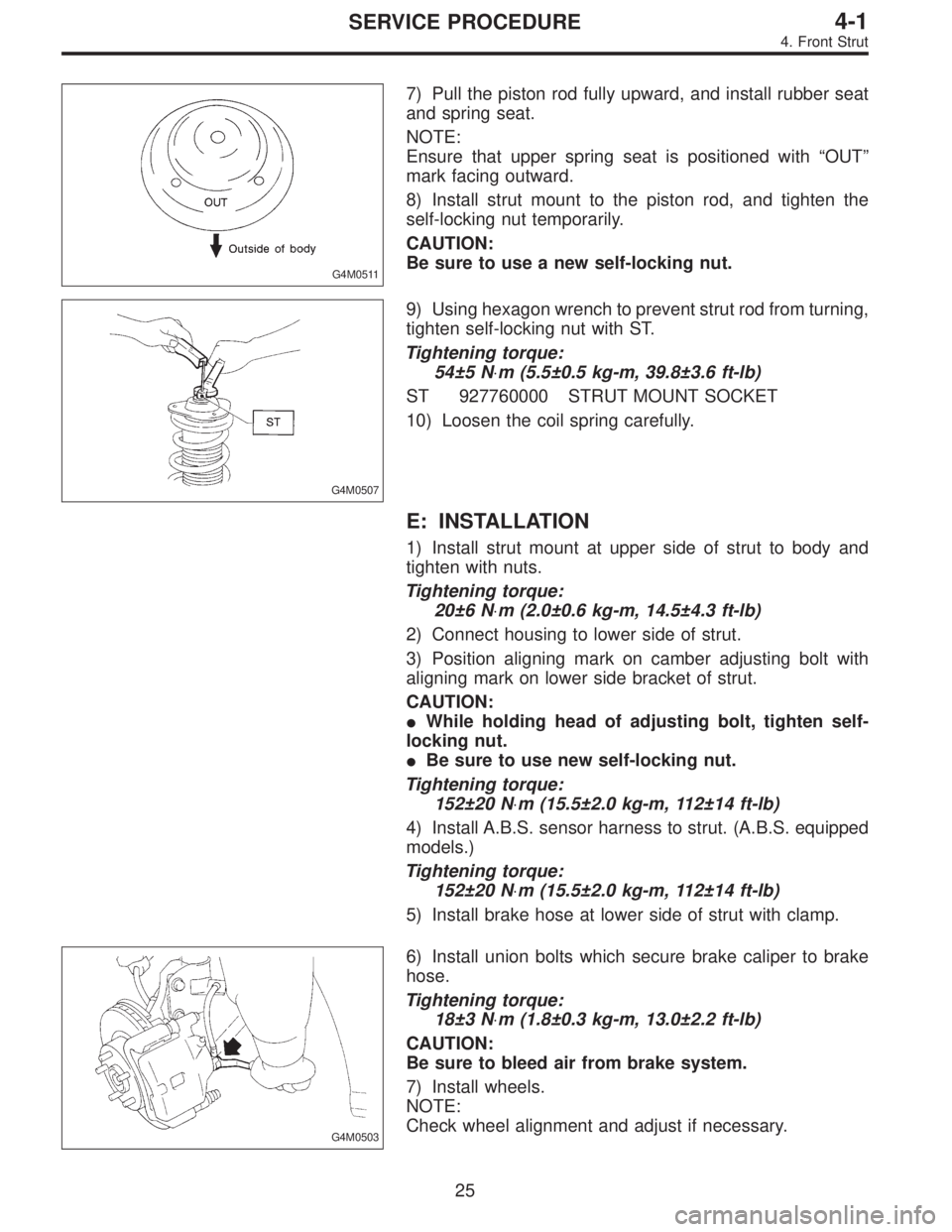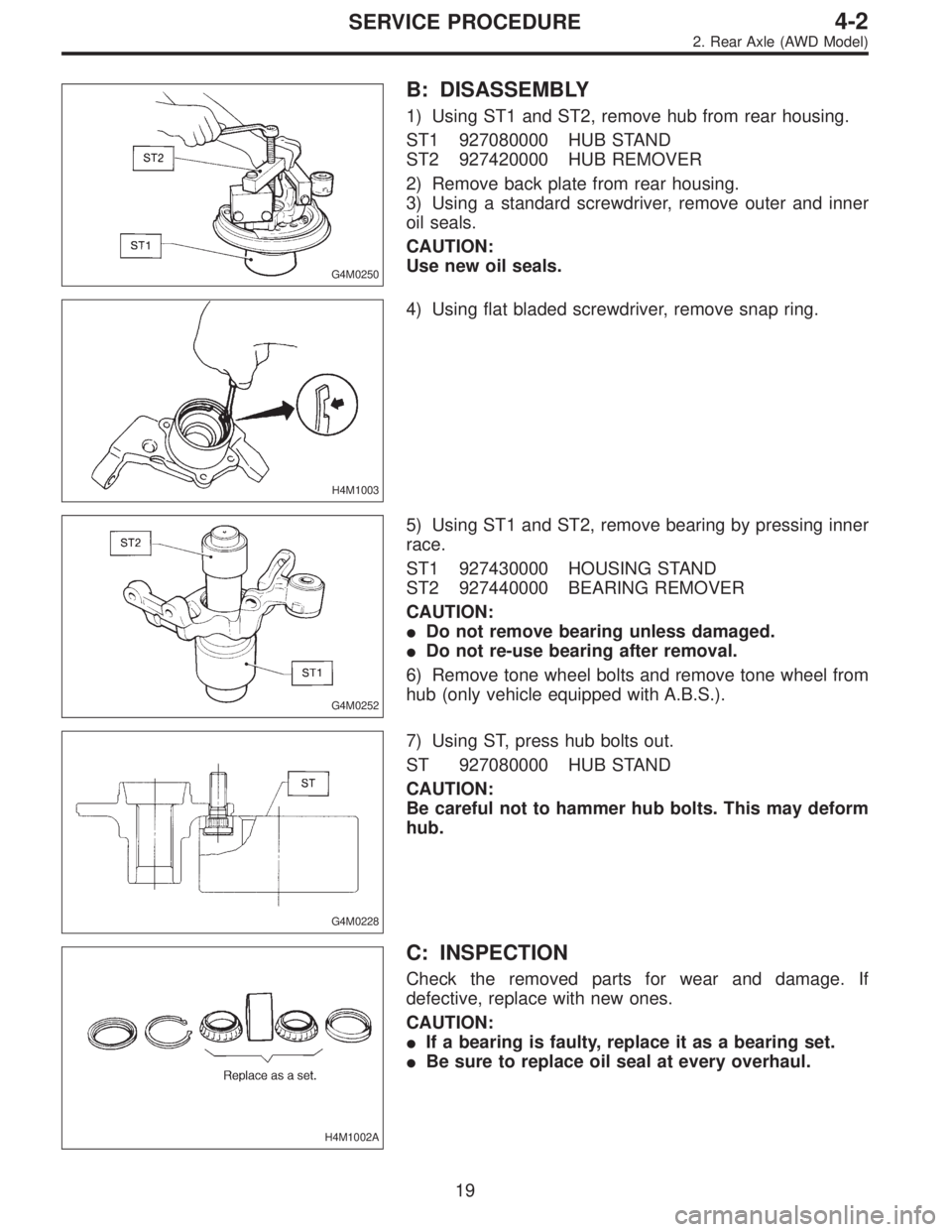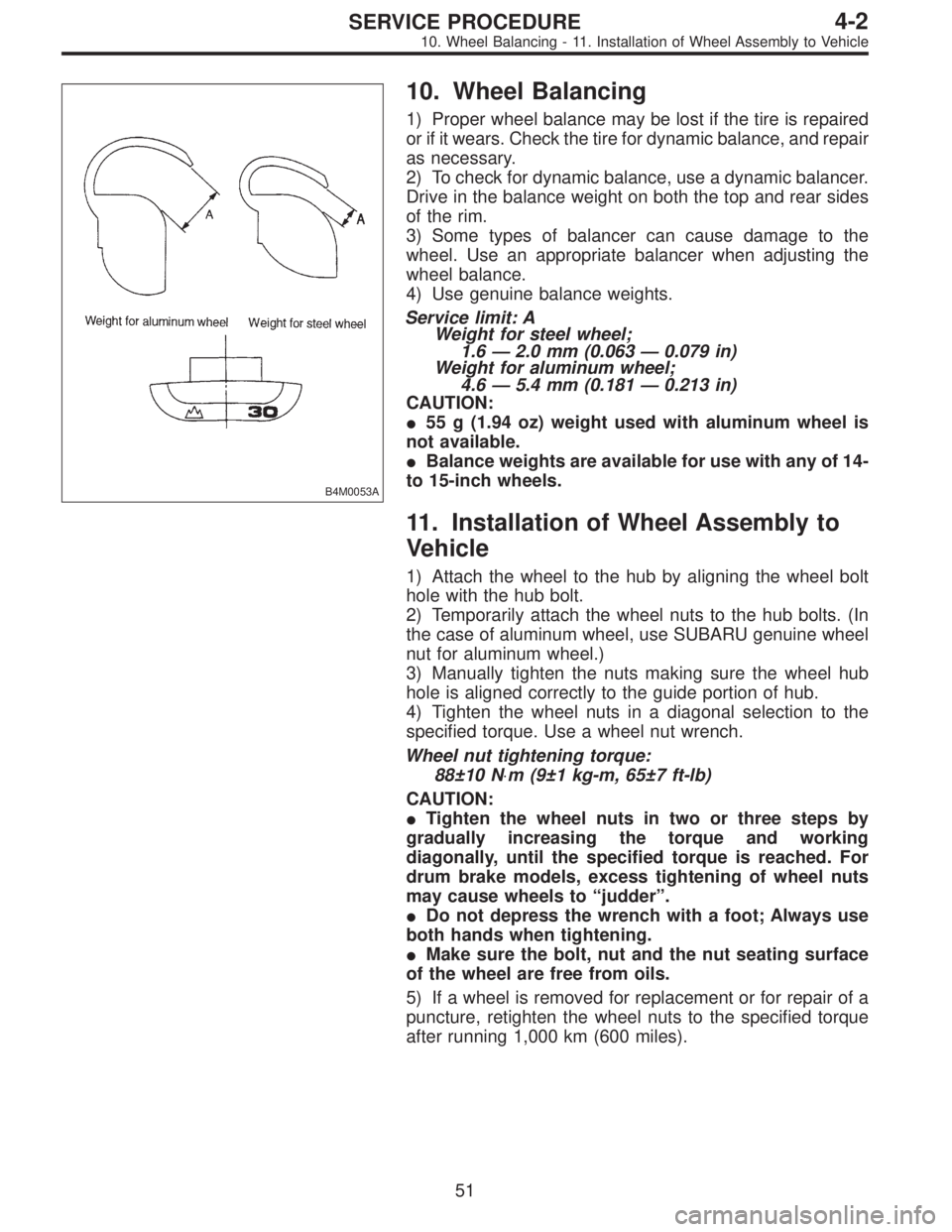Page 1024 of 2890

C: INSPECTION
Check the disassembled parts for cracks, damage and
wear, and replace with new parts if defective.
G4M0508
1. DAMPER STRUT
1) Check for oil leakage.
2) Move the piston rod up and down to check its operates
smoothly without any binding.
3) Play of piston rod
Measure the play as follows:
Fix outer shell and fully extend the rod. Set a dial gauge at
the end of the rod: L [10 mm (0.39 in)], then apply a force
of W [20 N (2 kg, 4 lb)] to threaded portion. With the force
of 20 N (2 kg, 4 lb) applied, read dial gauge indication: P
1.
Apply a force of 20 N (2 kg, 4 lb) in the opposite direction
of“W”, then read dial gauge indication: P
2. The free play
is determined by the following equation:
Play = P
1,P2
Limit of play:
Less than 0.8 mm (0.031 in)
If the play is greater, replace the strut with new one.
2. STRUT MOUNT
Check rubber part for wear, cracks and deterioration, and
replace it with new one if defective.
3. DUST COVER
If any cracks or damage are found, replace it with new one.
4. COIL SPRING
When vehicle posture is uneven, although there are no
considerable reasons like tire puncture, uneven loading,
etc., check coil spring and spring seats for cracks,
deformation, etc., and replace it with a new one if defective.
5. HELPER
Replace it with new one if cracked or damaged.
23
4-1SERVICE PROCEDURE
4. Front Strut
Page 1025 of 2890

D: ASSEMBLY
1) Before installing coil spring, strut mount, etc., on the
strut, check for the presence of air in the dampening force
generating mechanism of the strut since air prevents
proper dampening force from being produced.
2) Checking for the presence of air
(1) Place the strut vertically with the piston rod facing
upward.
(2) Move the piston rod to the center of its entire
stroke.
(3) While holding the piston rod end with finger-tips,
move the rod up and down.
(4) If the piston rod moves at least 10 mm (0.39 in) in
step (3), purge air from the strut.
3) Air purging procedure
(1) Place the strut vertically with the piston rod facing
upward.
(2) Fully extend the piston rod.
(3) With the piston rod fully extended, place the piston
rod side down. The strut must stand vertically.
(4) Fully contract the piston rod.
(5) Repeat 3 or 4 times steps (1) through (4) above.
NOTE:
After completely purging air from the strut, be sure to place
the strut with the piston rod facing upward. If it is laid down,
check for entry of air in the strut as outlined under item 2)
above.
B4M0568A
4) Using a coil spring compressor, compress the coil
spring.
NOTE:
Make sure that the vertical installing direction of coil spring
is as shown in figure.
G4M0510
5) Set the coil spring correctly so that its end face fits well
into the spring seat as shown.
6) Install helper and dust cover to the piston rod.
24
4-1SERVICE PROCEDURE
4. Front Strut
Page 1026 of 2890

G4M0511
7) Pull the piston rod fully upward, and install rubber seat
and spring seat.
NOTE:
Ensure that upper spring seat is positioned with“OUT”
mark facing outward.
8) Install strut mount to the piston rod, and tighten the
self-locking nut temporarily.
CAUTION:
Be sure to use a new self-locking nut.
G4M0507
9) Using hexagon wrench to prevent strut rod from turning,
tighten self-locking nut with ST.
Tightening torque:
54±5 N⋅m (5.5±0.5 kg-m, 39.8±3.6 ft-lb)
ST 927760000 STRUT MOUNT SOCKET
10) Loosen the coil spring carefully.
E: INSTALLATION
1) Install strut mount at upper side of strut to body and
tighten with nuts.
Tightening torque:
20±6 N⋅m (2.0±0.6 kg-m, 14.5±4.3 ft-lb)
2) Connect housing to lower side of strut.
3) Position aligning mark on camber adjusting bolt with
aligning mark on lower side bracket of strut.
CAUTION:
�While holding head of adjusting bolt, tighten self-
locking nut.
�Be sure to use new self-locking nut.
Tightening torque:
152±20 N⋅m (15.5±2.0 kg-m, 112±14 ft-lb)
4) Install A.B.S. sensor harness to strut. (A.B.S. equipped
models.)
Tightening torque:
152±20 N⋅m (15.5±2.0 kg-m, 112±14 ft-lb)
5) Install brake hose at lower side of strut with clamp.
G4M0503
6) Install union bolts which secure brake caliper to brake
hose.
Tightening torque:
18±3 N⋅m (1.8±0.3 kg-m, 13.0±2.2 ft-lb)
CAUTION:
Be sure to bleed air from brake system.
7) Install wheels.
NOTE:
Check wheel alignment and adjust if necessary.
25
4-1SERVICE PROCEDURE
4. Front Strut
Page 1059 of 2890
H4M1001
5) Using flat bladed screwdriver, remove snap ring.
G4M0227
6) Using ST1, support housing securely.
7) Using ST2, press inner race to drive out outer bearing.
ST1 927400000 HOUSING STAND
ST2 927100000 BEARING REMOVER
CAUTION:
�Do not remove outer race unless it is faulty.
�Discard outer race after removal.
�Do not replace inner or outer race separately;
always replace as a unit.
8) Loosen bolts which secure tone wheel to hub. Remove
tone wheel (only vehicle equipped with A.B.S.).
G4M0228
9) Using ST and a hydraulic press, drive hub bolts out.
ST 927080000 HUB STAND
CAUTION:
Be careful not to hammer hub bolts. This may deform
hub.
H4M1002A
C: INSPECTION
Check the removed parts for wear and damage. If
defective, replace with new ones.
CAUTION:
�If bearing is faulty, replace it as a bearing set.
�Be sure to replace oil seal at every overhaul.
12
4-2SERVICE PROCEDURE
1. Front Axle
Page 1067 of 2890

G4M0250
B: DISASSEMBLY
1) Using ST1 and ST2, remove hub from rear housing.
ST1 927080000 HUB STAND
ST2 927420000 HUB REMOVER
2) Remove back plate from rear housing.
3) Using a standard screwdriver, remove outer and inner
oil seals.
CAUTION:
Use new oil seals.
H4M1003
4) Using flat bladed screwdriver, remove snap ring.
G4M0252
5) Using ST1 and ST2, remove bearing by pressing inner
race.
ST1 927430000 HOUSING STAND
ST2 927440000 BEARING REMOVER
CAUTION:
�Do not remove bearing unless damaged.
�Do not re-use bearing after removal.
6) Remove tone wheel bolts and remove tone wheel from
hub (only vehicle equipped with A.B.S.).
G4M0228
7) Using ST, press hub bolts out.
ST 927080000 HUB STAND
CAUTION:
Be careful not to hammer hub bolts. This may deform
hub.
H4M1002A
C: INSPECTION
Check the removed parts for wear and damage. If
defective, replace with new ones.
CAUTION:
�If a bearing is faulty, replace it as a bearing set.
�Be sure to replace oil seal at every overhaul.
19
4-2SERVICE PROCEDURE
2. Rear Axle (AWD Model)
Page 1075 of 2890
G4M0276
2) Remove back plate from rear spindle.
G4M0277
3) Using ST, press hub bolts out.
CAUTION:
Do not hammer hub bolt since this may deform hub.
ST 927080000 HUB STAND
C: INSPECTION
Clean the removed parts and check them for wear, dam-
age and corrosion. If faulty, replace.
CAUTION:
Hub unit cannot be disassembled. If faulty, replace it
as a unit.
G4M0278
D: ASSEMBLY
1) Using ST, press new hub bolts into place.
NOTE:
�Use a 12 mm (0.47 in) hole in ST to prevent hub bolt
from tilting during installation.
�Ensure hub bolt closely contacts hub.
ST 927080000 HUB STAND
2) Completely clean dust or dirt from the mating/polished
surface of rear spindle back plate.
3) Install back plate to rear spindle.
Tightening torque:
52±6 N⋅m (5.3±0.6 kg-m, 38.3±4.3 ft-lb)
4) Charge oil seal located on the rear of hub with grease.
Specified grease:
SHELL 6459N
26
4-2SERVICE PROCEDURE
3. Rear Axle (FWD Model)
Page 1103 of 2890

B4M0053A
10. Wheel Balancing
1) Proper wheel balance may be lost if the tire is repaired
or if it wears. Check the tire for dynamic balance, and repair
as necessary.
2) To check for dynamic balance, use a dynamic balancer.
Drive in the balance weight on both the top and rear sides
of the rim.
3) Some types of balancer can cause damage to the
wheel. Use an appropriate balancer when adjusting the
wheel balance.
4) Use genuine balance weights.
Service limit: A
Weight for steel wheel;
1.6—2.0 mm (0.063—0.079 in)
Weight for aluminum wheel;
4.6—5.4 mm (0.181—0.213 in)
CAUTION:
�55 g (1.94 oz) weight used with aluminum wheel is
not available.
�Balance weights are available for use with any of 14-
to 15-inch wheels.
11. Installation of Wheel Assembly to
Vehicle
1) Attach the wheel to the hub by aligning the wheel bolt
hole with the hub bolt.
2) Temporarily attach the wheel nuts to the hub bolts. (In
the case of aluminum wheel, use SUBARU genuine wheel
nut for aluminum wheel.)
3) Manually tighten the nuts making sure the wheel hub
hole is aligned correctly to the guide portion of hub.
4) Tighten the wheel nuts in a diagonal selection to the
specified torque. Use a wheel nut wrench.
Wheel nut tightening torque:
88±10 N⋅m (9±1 kg-m, 65±7 ft-lb)
CAUTION:
�Tighten the wheel nuts in two or three steps by
gradually increasing the torque and working
diagonally, until the specified torque is reached. For
drum brake models, excess tightening of wheel nuts
may cause wheels to “judder”.
�Do not depress the wrench with a foot; Always use
both hands when tightening.
�Make sure the bolt, nut and the nut seating surface
of the wheel are free from oils.
5) If a wheel is removed for replacement or for repair of a
puncture, retighten the wheel nuts to the specified torque
after running 1,000 km (600 miles).
51
4-2SERVICE PROCEDURE
10. Wheel Balancing - 11. Installation of Wheel Assembly to Vehicle
Page 1104 of 2890

B4M0053A
10. Wheel Balancing
1) Proper wheel balance may be lost if the tire is repaired
or if it wears. Check the tire for dynamic balance, and repair
as necessary.
2) To check for dynamic balance, use a dynamic balancer.
Drive in the balance weight on both the top and rear sides
of the rim.
3) Some types of balancer can cause damage to the
wheel. Use an appropriate balancer when adjusting the
wheel balance.
4) Use genuine balance weights.
Service limit: A
Weight for steel wheel;
1.6—2.0 mm (0.063—0.079 in)
Weight for aluminum wheel;
4.6—5.4 mm (0.181—0.213 in)
CAUTION:
�55 g (1.94 oz) weight used with aluminum wheel is
not available.
�Balance weights are available for use with any of 14-
to 15-inch wheels.
11. Installation of Wheel Assembly to
Vehicle
1) Attach the wheel to the hub by aligning the wheel bolt
hole with the hub bolt.
2) Temporarily attach the wheel nuts to the hub bolts. (In
the case of aluminum wheel, use SUBARU genuine wheel
nut for aluminum wheel.)
3) Manually tighten the nuts making sure the wheel hub
hole is aligned correctly to the guide portion of hub.
4) Tighten the wheel nuts in a diagonal selection to the
specified torque. Use a wheel nut wrench.
Wheel nut tightening torque:
88±10 N⋅m (9±1 kg-m, 65±7 ft-lb)
CAUTION:
�Tighten the wheel nuts in two or three steps by
gradually increasing the torque and working
diagonally, until the specified torque is reached. For
drum brake models, excess tightening of wheel nuts
may cause wheels to “judder”.
�Do not depress the wrench with a foot; Always use
both hands when tightening.
�Make sure the bolt, nut and the nut seating surface
of the wheel are free from oils.
5) If a wheel is removed for replacement or for repair of a
puncture, retighten the wheel nuts to the specified torque
after running 1,000 km (600 miles).
51
4-2SERVICE PROCEDURE
10. Wheel Balancing - 11. Installation of Wheel Assembly to Vehicle